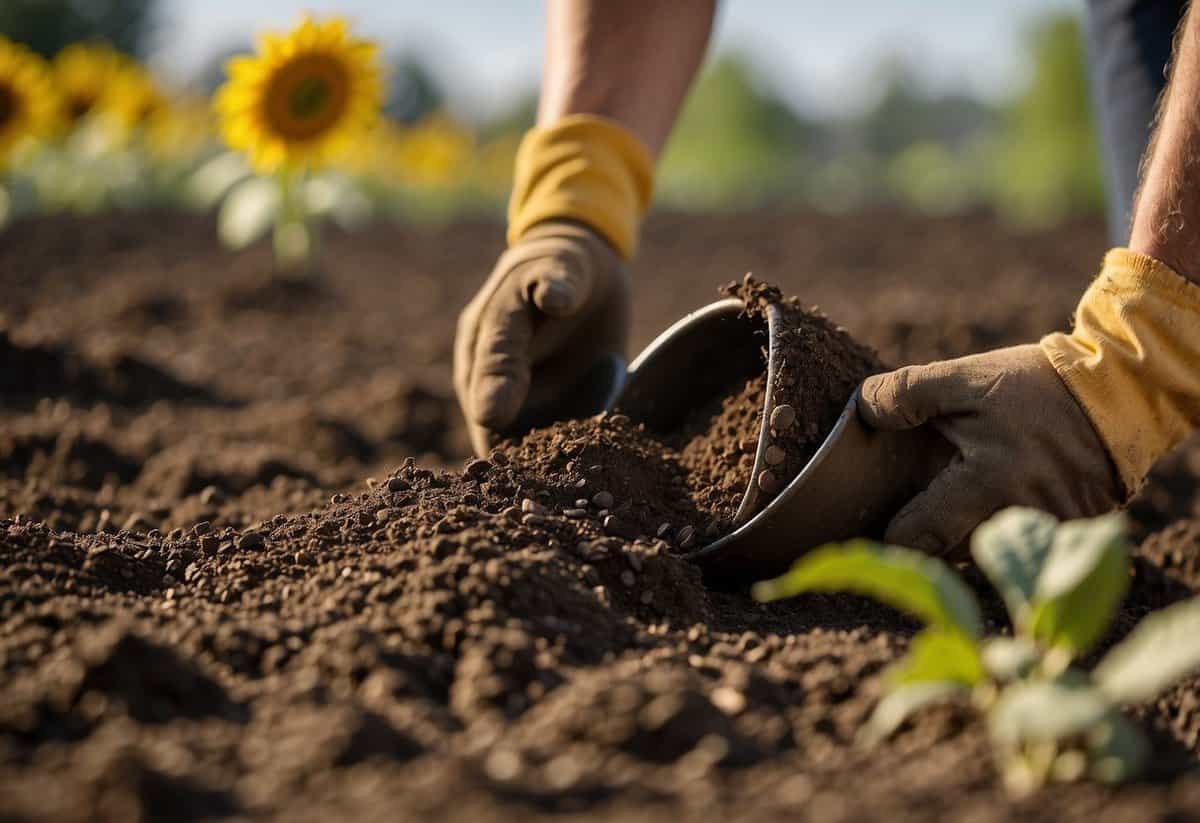Sunflower Garden Tips: Easy Steps for a Bright and Blooming Yard
Sunflowers brighten up any garden with their cheerful, towering blooms. If you’ve always wanted to grow your own sunflower garden, you’re in the right place. These stunning flowers are perfect for summer and can add a pop of color to your yard.

What are the best tips for growing and caring for sunflowers? This article will provide you with helpful advice to ensure your sunflowers thrive. From planting methods to care tips, you’ll learn everything you need to create a beautiful sunflower garden.
1) Choose the Right Sunflower Variety

When starting your sunflower garden, picking the right variety is key. There are many types, like the classic yellow and the striking red-hued Velvet Queen.
Consider the size of your garden. Some sunflowers grow over 12 feet tall, while dwarf types are great for containers.
Think about the color palette of your garden. Traditional yellow sunflowers, like Vincent’s Choice, bring a sunny touch. Red, orange, and even white sunflowers can add unique beauty.
2) Plant in a Sunny Spot

Sunflowers thrive on sunlight. They need 6 to 8 hours of direct sunlight every day. Look for a location in your garden that gets plenty of sun.
Avoid planting in shady areas. Sunflowers use sunlight to grow tall, strong, and produce big blooms. A sunny spot ensures they reach their full potential.
Pick a location that’s sheltered from strong winds to keep your sunflowers from toppling over as they mature. A spot near a fence or building works great. For more details, refer to this guide on planting sunflowers.
3) Prepare the Soil Well

Sunflowers do best in well-draining soil that is rich in organic matter.
Loosen the soil with a garden fork or tiller. Dig about 2 feet deep to make sure the roots have plenty of space.
Add compost or aged manure to enrich the soil. This helps the plants grow strong and healthy. For more details, visit Gardenia.
4) Space Your Sunflowers Properly

Proper spacing is key to healthy sunflowers. Plant the seeds about 6 to 12 inches apart if you want larger flowers.
For smaller, more compact flowerheads, you can plant them closer together, around 1 to 2 inches apart. This is useful for making bouquets.
Proper spacing ensures your sunflowers get enough light and nutrients to grow strong and vibrant.
More info on growing sunflowers.
5) Water Generously

When it comes to sunflowers, keeping the soil moist is key. Sunflowers need about 1-2 inches of water each week.
Water your sunflowers deeply and thoroughly, allowing the water to reach their roots.
Check the soil moisture regularly. You can do this by sticking your finger about an inch into the soil. If it feels dry, it’s time to water.
In hot weather, young sunflowers might need watering every day. For more details, you can visit this guide.
6) Protect from Pests

To keep your sunflowers safe, start by planting marigolds and chives nearby. They help repel pests.
If you spot bugs on your sunflowers, consider using neem oil or insecticidal soap. Both are effective and safe for plants.
You can also introduce beneficial insects like ladybugs to control the pest population.
7) Support Tall Sunflowers

Tall sunflowers can sometimes droop or fall over. To help them stand tall, use stakes or bamboo sticks. Tie the stems gently to the supports with soft ties or garden twine. Make sure not to tie too tightly to avoid damaging the plant.
Another tip is to use a potassium-rich fertilizer to make the stems stronger. This helps sunflowers stay upright and resist drooping.
8) Harvest Seeds for Future Planting

To harvest sunflower seeds for future planting, wait until the back of the flower heads turns brown. This usually happens after the petals wilt and fall off.
Cut the heads from the stems, leaving a few inches of stem attached. Hang the heads in a well-ventilated area to dry.
Once dry, rub the seeds off using your hands or a fork. Store the seeds in a cool, dry place until you’re ready to plant them.
For more detailed instructions, visit Harvesting Sunflower Seeds: A Step-by-Step Guide for Gardeners.
9) Deadhead for Continuous Blooms

To keep your sunflowers blooming, you need to deadhead them regularly. Start deadheading when the flowers begin to wilt and fade. This usually happens about 7-10 days after they fully bloom.
Using sharp and clean pruning shears, cut the stem just above the new leaves or leaf joint. Removing the spent flowers will encourage new blooms and can improve plant health.
After deadheading, be sure to water your plants well and provide them with the necessary nutrients. This will help your sunflowers produce vibrant new blooms.
10) Ensure Proper Drainage

Good drainage is key for healthy sunflowers. You should plant your sunflowers in well-draining soil to prevent waterlogging. Heavy clay soil can retain too much water, leading to root rot.
Adding organic matter like compost can help improve soil structure. Raised beds are another option to enhance drainage. Make sure water can flow freely away from the roots.
Choosing the Right Sunflower Varieties

Picking the right sunflower varieties for your garden means thinking about color, height, and space. Different types suit different needs and aesthetics, from tall giants to small container varieties.
Popular Sunflower Types
There are many sunflower varieties, each with unique traits. Traditional yellow sunflowers like Vincent’s Choice offer a classic garden look. For something bold, try red-hued varieties such as Evening Sun or Velvet Queen. If you want a mix of colors, Autumn Beauty showcases red, orange, and yellow petals and can reach 5-6 feet tall. Dwarf sunflowers like Topolino are perfect for smaller spaces. These small sunflowers grow only up to 16 inches but still branch out and produce many blossoms.
Selecting Sunflower Seeds
When choosing sunflower seeds, consider your garden layout and sunlight availability. Some sunflowers grow over 12 feet tall, demanding substantial sunlight and space, while dwarf varieties are better for containers and small areas. Look for seeds that meet your garden’s needs in terms of size and color. Read seed packets carefully to understand the growth requirements. For example, some sunflowers bloom from late summer to early fall, attracting pollinators. Varieties like Helianthus annuus ‘Autumn Beauty’ not only add color but also provide edible seeds, making them a great choice for both beauty and utility.
Planting and Soil Preparation

Planting sunflowers begins with selecting the right soil and knowing the perfect time to sow the seeds. Ensuring proper soil preparation and timing will set your sunflowers up for success.
Preparing the Soil
Sunflowers need well-draining soil. Choose a spot in your garden where water doesn’t pool after rain. They can grow in various soil types, but they prefer soil rich in organic matter.
Before planting, loosen the soil to about 2 feet deep. You can use a garden fork or tiller. Adding compost or aged manure will provide the nutrients your sunflowers need. If your soil is heavy clay, mix in some sand to improve drainage. A neutral to slightly alkaline pH between 6.0 and 7.5 is ideal.
Spacing is also important. Depending on the sunflower variety, seeds should be spaced 6 to 36 inches apart. For more compact flower heads, plant seeds closer together, around 1 to 2 inches apart.
Optimal Planting Times
Sunflowers need warm soil to germinate. Start planting when the soil temperature reaches at least 55°F (13°C). The ideal temperature is between 70°F and 75°F (21°C to 25°C).
Choose a location that gets full sun exposure—about 6 to 8 hours of direct sunlight per day. You can plant sunflowers directly in the garden or start seeds indoors.
Early spring is a great time to begin, but be mindful of your local frost dates. Avoid planting before the last frost to protect young seedlings. If you want continuous blooms, plant additional seeds every 2 to 3 weeks until mid-summer. This will ensure a steady supply of beautiful sunflowers for your garden.
Watering and Fertilizing Techniques

Proper watering and fertilizing are key to growing strong, healthy sunflowers. Knowing how much water your plants need and choosing the right fertilizers can make all the difference.
Determining Water Needs
Sunflowers need consistent watering, especially during dry periods. Check the soil moisture to guide your watering schedule. Insert a moisture meter into the soil to see if it’s too dry or too wet.
Aim to keep the soil consistently moist but not waterlogged. Overwatering can lead to root rot. Water deeply, ensuring the water reaches the roots. Mulching around the base can help retain moisture and reduce the frequency of watering.
During the germination period, water daily. Once established, sunflowers typically need water 1-2 times a week, depending on rainfall and temperature.
Using Natural Fertilizers
Sunflowers thrive with the right nutrients. Natural fertilizers like compost or manure provide essential nutrients without chemical additives. These organic options improve soil quality and root health.
Compost is rich in nitrogen, phosphorus, and potassium, which are vital for sunflower growth. Apply a 2-3 inch layer of compost around the base of the plant. Well-rotted manure is another excellent choice, mixed into the soil before planting.
In addition to compost and manure, consider using liquid seaweed or fish emulsion. These fertilizers offer quick nutrient uptake and support robust growth. Apply them every few weeks during the growing season for best results.
For more detailed guides, visit sunflower watering tips and sunflower fertilization techniques.







